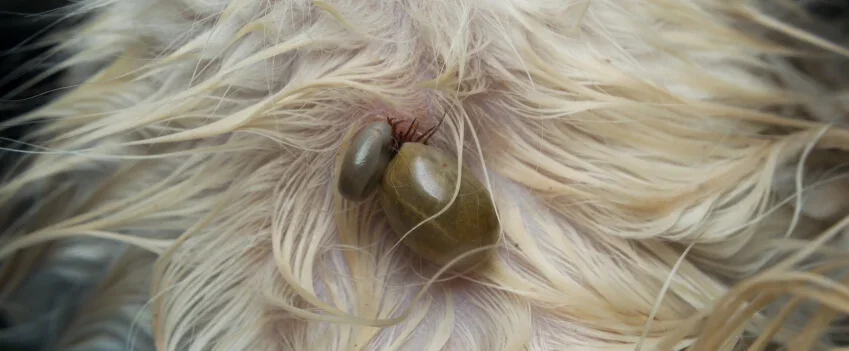There are a vast number of insects that can bite our pets, resulting in a vast array of associated symptoms that you may see. However, the most common symptom is raised, red lumps or hives. The individual symptoms of different insects is discussed in more detail below.
Just like humans, some dogs can experience an allergic, or anaphylactic reaction to an insect bite, causing profound swelling, difficulty breathing, vomiting, diarrhoea, tremors, collapse and coma. These signs warrant immediate veterinary attention.
Mosquitoes
The mosquito bite is a familiar sight in Summer and the bites that appear on our pets look just like those on us! You'll probably notice a round welt under 1cm wide appear on your pup's skin. In pale skin dogs they may also appear red, but they are typically covered with fur. They will be itchy and typically occur individually, but sometimes can appear close together.
Bee and Wasp Stings
You've probably seen a picture of a dog post-bee sting. These are often depicted as 'cute' photos of dogs with their faces all swollen. This swollen face is typical of a severe allergic reaction though; not all dogs will swell up!
Some dogs may present with milder symptoms, including:
- Yelping, whining or limping due to pain
- Licking, chewing, scratching or pawing at the bite site
- Redness and swelling of bite site
- Hives
- Pain when touched
- Swelling
- Drooling
- Full body itch
- Visible sting/stinger
Fly and Midge Bites
There are a variety of biting flies in Australia, including Midges (Sand Flies), March Flies (Horse Flies) and Black Flies. All of these flies can inflict painful bites. Most will present as the typical raised, red swollen lump and occasionally with be very itchy.
Because these bites are often most painful when they initially occur, you will probably see your dog spin around or snap at these flies to shoo them away.
Ant Bites
Ants are commonly found in the backyard and it's easy for curious pups to sniff out a nest or accidentally lie down in an ant's nest. There are many types of feisty ants in Australia and some have a sting that is even more fearsome than its bite (don't forget the acid squirting Green Tree Ant!). It's uncommon for an ant bite to cause an allergic reaction, but always keep an eye on your pet.
Signs of an ant bite can include:
- Holding up the paw/leg
- Flicking or shaking the paw
- Sudden redness between the toes
- Licking or chewing at the bite site
- Mild swelling at bite site
- Small red spot, possibly with a white centre like a pimple (esp. Fire ants)
Spider Bites
If there is one thing Australia is well known for, it's our long list of deadly snakes and spiders. As such, pet owners generally know what to look out for in themselves, but what about your dog?
With a vast number of spiders in Australia, we can see a range of bite reactions as well, although they tend to be non-specific. Often a spider bite is never confirmed, or the species confirmed when it comes to our pets.
Most spider bites will induce a localised reaction, with a thick, red welt at the bite site often associated with tenderness or pain, and general lethargy. Sometimes tissue around the bite site may also die (skin may turn black and start to fall away or discharge).
Obviously, with some spiders, more severe reactions can occur, such as the Redback Spider. Redback venom affects the nerves, with initial pain at the bite site, followed by full body pain, particularly from touch. Other spiders can cause paralysis, muscle tremors, joint pain, anxiety/restlessness, limping/lifting the paw, difficulty walking, reduced appetite, vomiting, diarrhoea and difficulty breathing.
All spider bites should be taken seriously as there is no antivenom available and anaphylactic reactions can occur. Treatment is supportive and based on managing symptoms. If you suspect your dog has been bitten by a spider, take them to the vet immediately.



